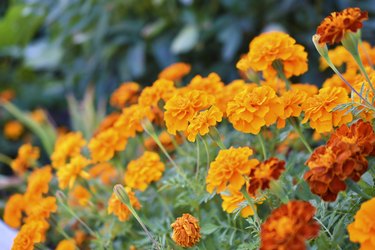
What's not to like about marigolds? They are hardy annuals and popular bedding plants that produce sunny flowers reliably. Marigolds are easy to care for, and they shrug off heat and drought that would wilt most other plants. On top of all that, they are easy to propagate, so once you have marigolds established in your yard, you can grow more without buying anything.
Meet the Marigold
Video of the Day
Marigolds (Tagetes spp.) are grown for their cheery, pompom flowers in citrus shades that appear in early summer and keep blooming through the summer heat. They finally call it a day after the first hard frost in fall. The two main categories of marigolds are the African marigold (Tagetes erecta), which is taller with big flowers up to 4 inches across, and the French marigold (Tagetes patula), which is shorter and more mounding with smaller flowers.
Video of the Day
Both types have single or double flowers in shades of red, yellow, orange, and even gold, sometimes with contrasting markings. The blossoms are toxic, so don't eat them even if the slugs seem to enjoy them. The plant's foliage is green and feathery. They look best in mass plantings.
Care for Your Marigolds
You might think such show-stopping flowers would be hard to coax into top form, but nothing could be further from the truth. They are easy to grow and even easier to care for assuming you site them correctly. They absolutely must be in a location with full sun to bloom, and they need soil that is slightly acidic and that drains easily. You can work organic compost into the soil before planting or use a slow-release fertilizer, but many gardeners forgo any soil amendment and still have stunning flowers.
Marigolds tolerate the heat of summers in Florida without batting a petal, but they do like a reasonable amount of irrigation. Of course, you'll need to water marigolds well when you plant them and a few weeks after. Once they are established, 1 inch of water a week will make them happy.
Propagate Your Marigolds
Marigolds are fast and easy to grow from seed, so this is the way most gardeners propagate the flowers. If you deadhead your flowers when they wilt, you can separate the seeds and sow them for the next year's crop.
It's also possible to propagate marigolds from cuttings. Cut off pieces of stems between 2 and 6 inches long using clean, sharp garden scissors. Each should have three sets of leaves but no flowers. Remove all but the top set of leaves.
Prepare a tray with well-drained soilless potting mix, moisten it, and then poke planting holes with a screwdriver or stick and insert the cuttings one per hole with the cut end down. If desired, you can first dip the end in rooting hormone. Put the tray in a plastic bag in such a way that the bag doesn't touch the leaves. Move the entire tray arrangement into a warm, bright location with indirect light. Water to keep the soil damp. After a few weeks, the roots should form. When they are well established, transfer each rooted cutting to its own pot.